Effectiveness of the Regia Marina in WW2
In 1940 the Regia Marina was most ready and better equipped of the three Italian armed forces. It fought bravely for 39 months against superior enemies and lost almost 31,347 men. To determine the effectiveness of the Regia Marina in WW2, an analysis of the performance of the Regia Marina in the defense of Axis convoy must be done.
Strategy of the Regia Marina
The war fought in the Mediterranean Sea from June 1940 until the early months of 1943 was a long and painful struggle for the control and protection of communication and supply lines. Control of the sea was crucial for the war effort of the two main opponents of this battle; Italy and the British empire.
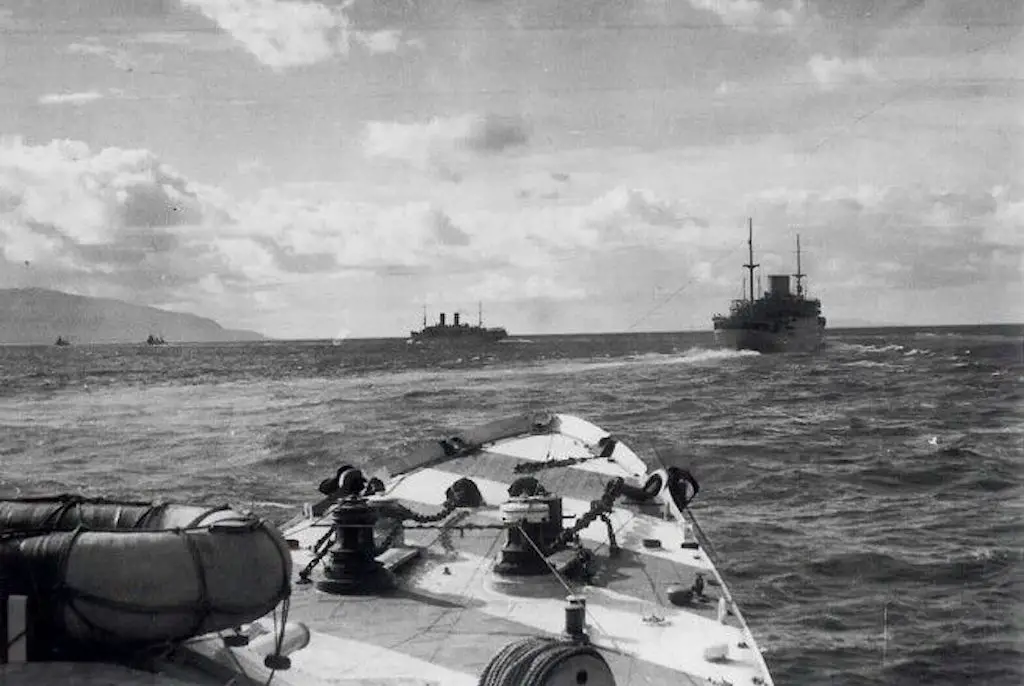
Italian convoy ships “Esperia” (left) and “Marco Polo” (right), off the coast of Libya with Destroyer escorts.
The Regia Marina had to protect the convoy routes from mainland Italy to the Libyan ports, mainly Tripoli and Benghazi. Likewise, the Royal Navy had the strategic goal to periodically re-supply Malta. It is no surprise that the biggest naval engagements resulted from actions aimed at disrupting enemy convoys or re-supply operations.
Clear examples of this are the Battle of Calabria, the Battle of Cape Spartivento, Operation Excess, Operation Halberd, the two clashes in the Sirte gulf, and the battles of mid-June and mid-August 1942 (Operation Harpoon and Pedestal). Without acknowledging the nature of the Mediterranean naval war, it is hard to understand the conduct and choices made by the two sides in the war for control of the sea routes. The two opponents never sought a decisive battle to annihilate each other because it simply did not serve their objectives.
This is particularly true for Italy, which did not have the industrial capacity to replace any capital ships lost. Even the production of Destroyers faced several limitations. Thus, Italy avoided risky and useless engagement against a superior enemy, who was able to replace its losses.
These factors led the Regia Marina to adopt a strategy resembling the Fleet in Being concept and exercising sea control in Central Mediterranean.
Port Limitations
Already in 1938, the Italian High Command analyzed the possibility of a war against Britain and France. The issue obviously being the problem of re-supplying Libya while fighting two of the world’s most powerful navies. A factor considered is that the three major Libyan ports available, Tripoli, Tobruk, and Benghazi, could manage contemporarily only 9, 3, and 5 ships respectively (G. Giorgerini, p.418) during peacetime. This limitation would obligate the Navy to organize and protect two weekly convoys encompassing 3-4 transport ships.
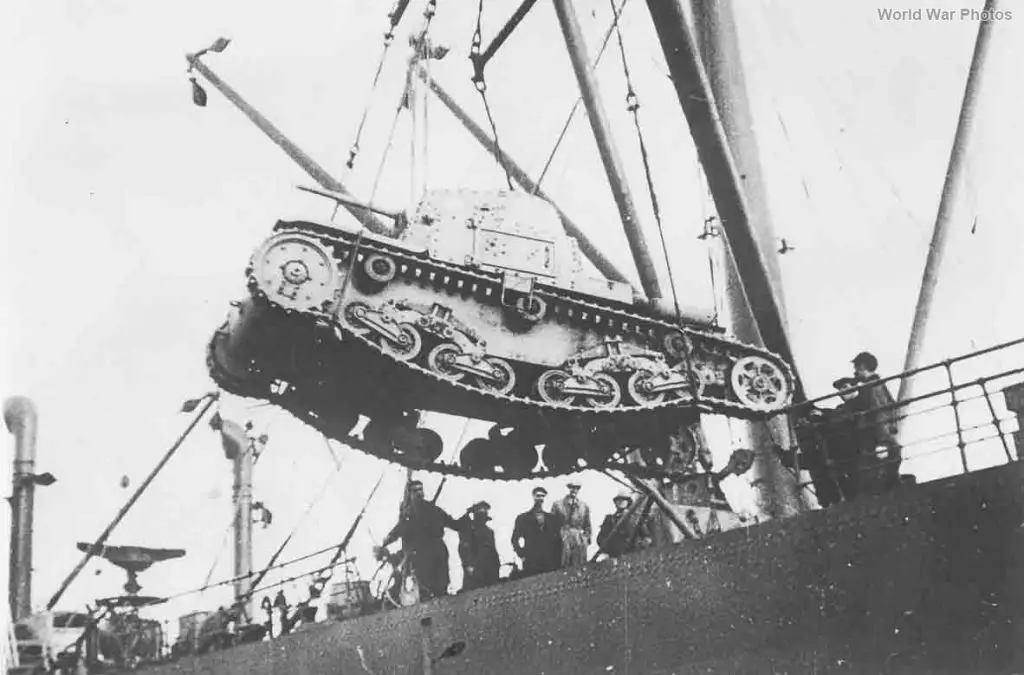
A 1941 photo of an M13/40 successfully arriving in Tripoli.
The reality of the war soon worsened the situation, Tobruk fell in January 1941, soon followed by Benghazi. This forced the Regia Marina to keep ships at sea every day in order to reinforce the Army, and later the Afrika Korps. Even with the recapture of Benghazi, its capacity was severely reduced and the port constantly subjected to air attacks. This left only Tripoli as the main entry point for the supplies destined to Rommel’s Panzerarmee. Unfortunately, Tripoli’s capacity became reduced to 50% by mid-1941. Additionally, following the arrival of the convoys, the vital supplies required delivery hundreds of kilometers by road or loaded on small boats hugging the coastline to the supply centers behind the frontline.
Results of Analysis
As a result, from 1940 to 1943, a total of 993 Axis convoys made their way towards Libya. This is an average of one convoy per day, including 1.9 transport ships and 2.2 escort vessels each (G. Giorgerini, p.437). Looking at the statistics below, the Regia Marina safely transported to North Africa 91.6% of the personnel and 85.9% of the materials shipped from the mainland. These numbers can boost the claim that the Regia Marina accomplished its main mission. It is a success achieved with severe technological and resource limitations while fighting against a superior enemy.
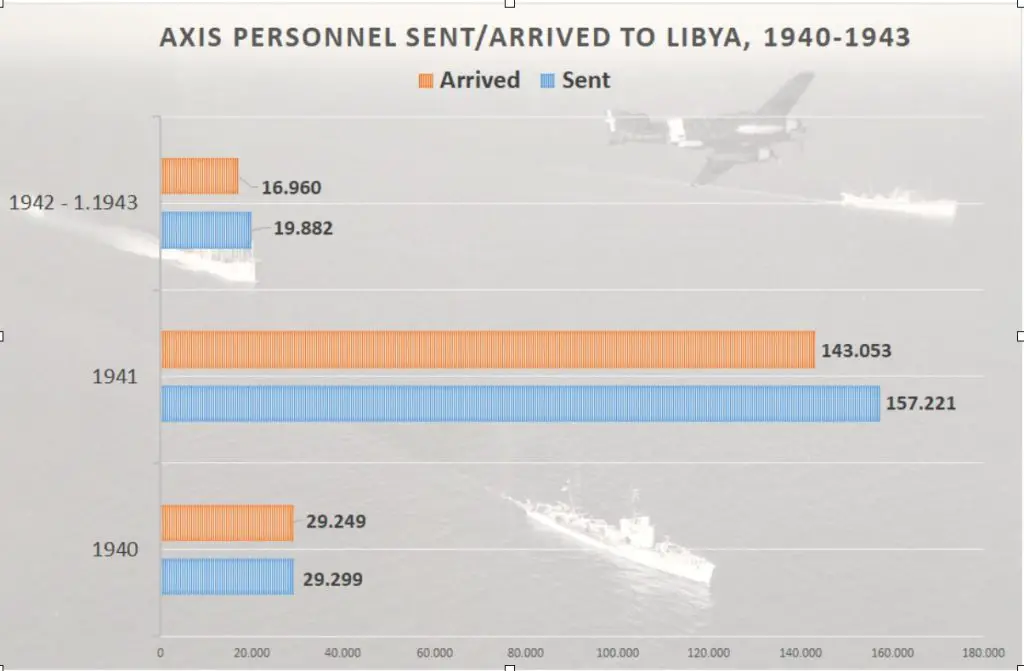
Axis personnel sent and successfully arriving in Libya 1940-1943.

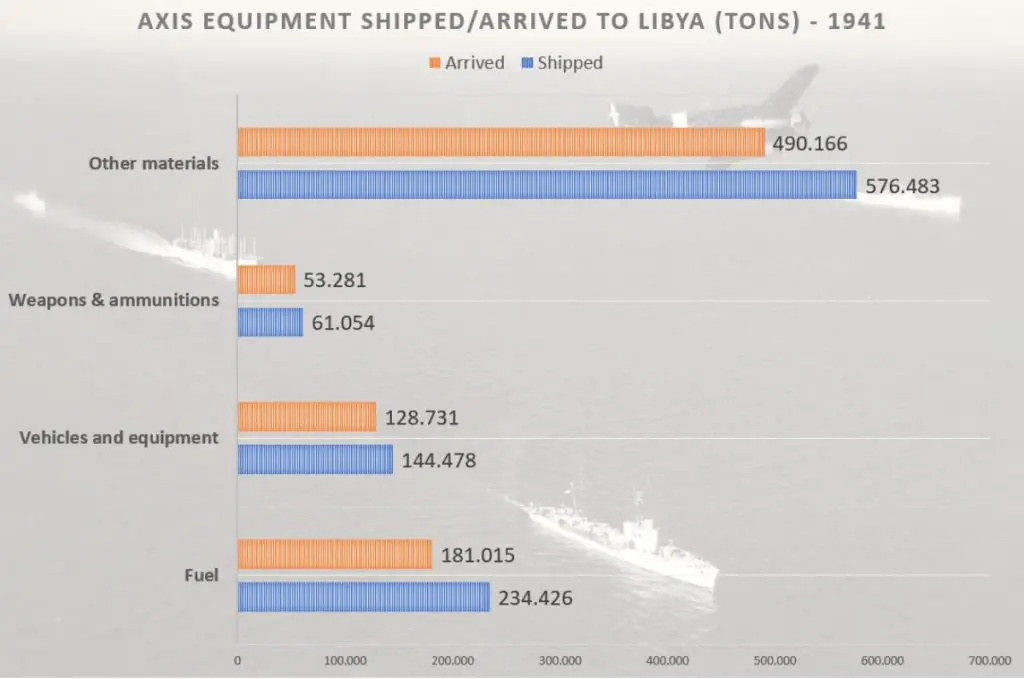
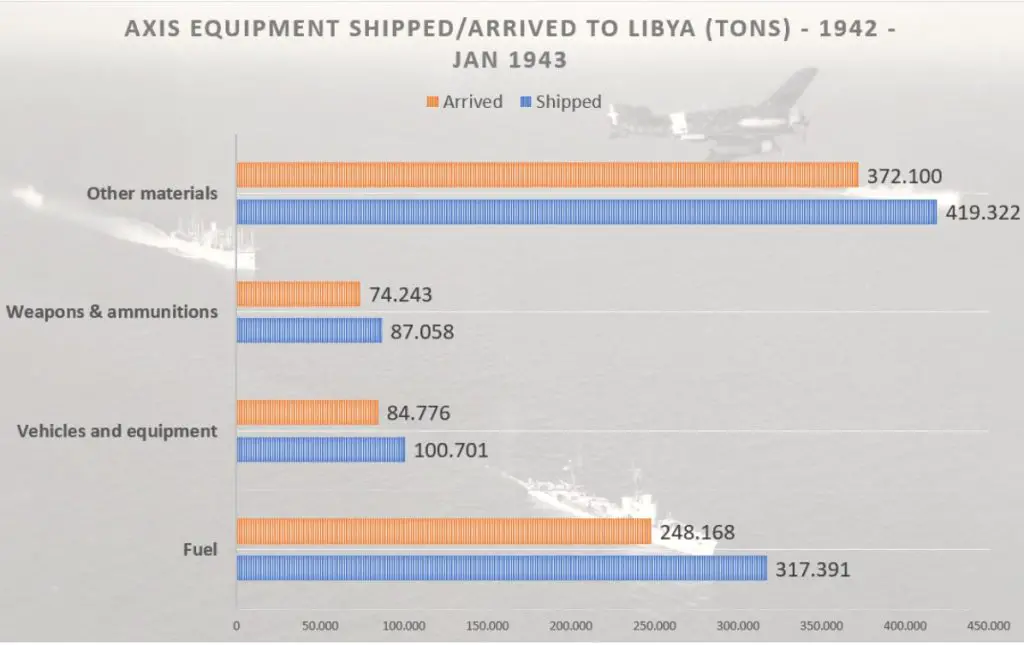
Regia Marina Convoys to Dodecanese and Albania
During the same period, the Regia Marina made a huge effort in protecting convoys to the Dodecanese Islands and Albania. This became a secondary priority following Axis operations in Greece and Yugoslavia. Italy dispatched a total of 3116 convoys (86 a month), with an average of 1.9 transport ships and 0.83 escort vessels. Along these routes, the convoys transferred 982,029 men, along with 1,970,050 tons of materials and equipment. The losses incurred were well below 0.5%.
British Attacks and Italian Escorts
The Royal Navy’s offensive against Italian convoys to Libya relied mainly on submarines and destroyers. Additional attacks came from aircraft of various types based in Malta. Unfortunately, precise data on these attacks could not be located. The graphs below summarize the history of such attacks and their outcomes in terms of ships hit. It is important to note that the ships hit dod not always result in the same number of ships sunk.
The first graph depicts the intensity of surface ship attacks mainly concentrated in three periods; April 1941, November-December 1941 and December 1942. They correspond to the deployment of destroyers and light cruisers in Malta, known from October 1941 as “Force K”. It is interesting to note that the naval presence in Malta and its effectiveness against Axis convoys is directly connected to the level of pressure put by the Luftwaffe and the Regia Aeronautica on Malta. For example, when the German 10th FliegerKorp based in Sicily redeployed to Russia in preparation for Barbarossa, the Allies managed to resupply Malta.
When Axis forces became overstretched at the end of 1941 and in the second half of 1942, Force K struck back. The second graph shows the much more effective submarine offensive. These attacks were carried out mainly by submarines of the U-class which kept constant pressure on Axis convoys.
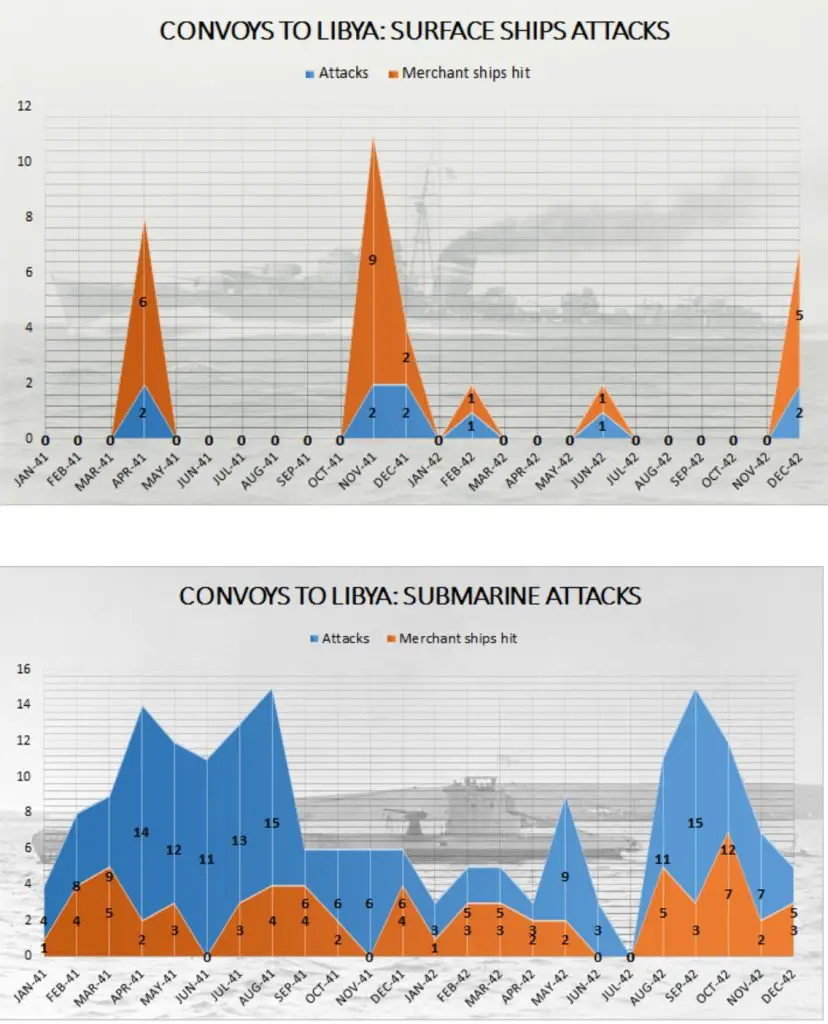
Allied attacks on Regia Marina Axis convoys.
Regia Marina Escorts
To protect convoys, the Regia Marina deployed a wide range of great war-era torpedo boats, auxiliary vessels, new Torpedo Boats of the Spica and Orsa class, Destroyers of the Navigatori, Dardo, Folgore, and Turbine class.
As the war progressed, the ranks of these ships became depleted by the never-ending activity. Destroyers of the Soldati, Maestrale, and Oriani classes, meant to operate alongside the battlefleet, progressively became assigned to convoy escort duties.
In late 1942 the excellent Gabbiano class corvettes joined in the defense of the convoys. However, it arrived too late to make a difference in the last months of the Convoy War. From time to time, depending on the urgency of the supplies and the riskiness of the routes followed, Condottieri or Trento class cruisers were deployed as an indirect escort to the most precious convoys. In some cases, especially when Force K was active, the Cavour and Andrea Dorea class battleships were sent as part of the indirect convoy escort.
Role of Air Units

An SM.79 Torpedo Bomber flying over a convoy.
The Regia Aeronautica and the Navy’s auxiliary air force took part in the convoy war with the aim of providing air cover, recognizance, and anti-submarine warfare. In these roles, a wide array of assets were used, among the most active we recall the fighters CR. 42, G.50 and MC.200, the SM.79 bombers and the seaplanes CANT Z501, Z506, Ro.43, and FIAT RS14. However, Italy never resolved the air-to-ship coordination issue, mainly due to the absence of a modern doctrine and lack of radio equipment.
Death Route to Tunisia
After the Second Battle of El Alamein, the remainder of Rommel’s Panzerarmee quickly retreated from Egypt. They then pulled out of Libya and set up a considerable presence in Tunisia. The final Axis resistance in North Africa required a constant re-supply. The Regia Marina, once again, relentlessly organized daily convoys to fuel this desperate struggle.
In 6 months, 276 convoys were sent. Each one with an average of 1.6 transport ships and 2 escort vessels. Due to the lack of merchant ships, the Regia Marina utilized 62 warships a month to transport supplies and personnel to Tunisia. This time the Regia Marina faced Force K, the newly constituted Force Q based in Bona, Algeria, the renewed British submarine offense and almost 5000 allied planes, mainly bombers, deployed in that theatre.
Against such unfavorable odds, the Regia Marina did its duty until the very last. However, it paid a heavy toll in terms of ships and men. Of the 344 merchant ships available in November 1942, Axis forces lost 254 in the course of this campaign, along with several escort vessels. Of these, 29 perished in April 1943. Approximately 93% of the Axis military personnel arrived in Tunisia and 71% of the equipment safely delivered.
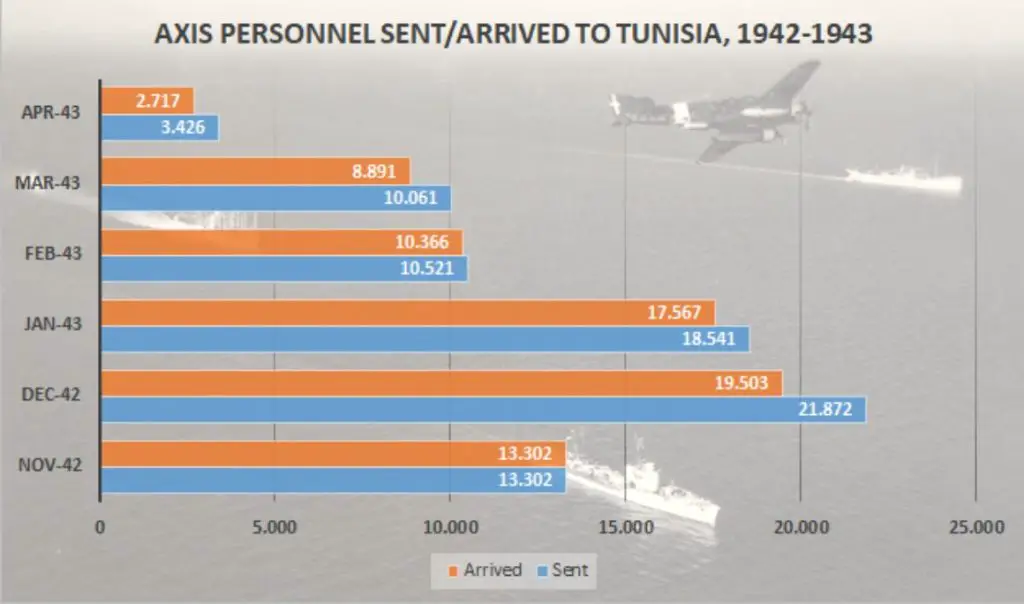
Personnel sent and delivered via Mediterranean convoys to Tunisia.
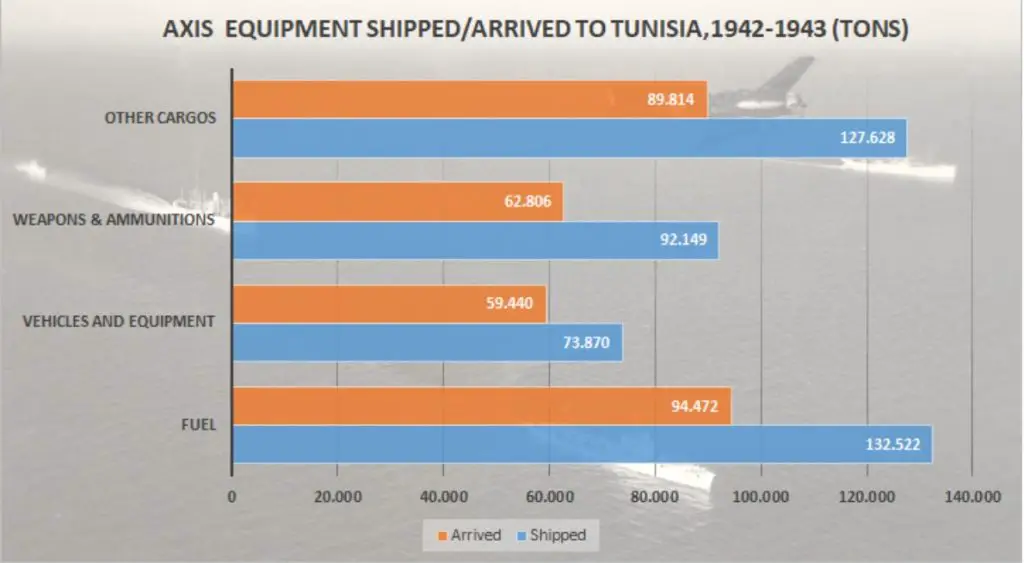
Equipment sent and delivered via Axis convoys to Tunisia.
Conclusions
The data shows the Italian navy met its strategic objectives and thus effectively maintained communication lines to North Africa. Of the hundreds of Axis convoys transported, 91.6% of the personnel and 86% of materials and equipment arrived safely in Libya. Furthermore, 93% and 71% of personnel and equipment arrived safely in Tunisia.
In some critical moments of the North African campaign, specifically the second half of 1941 and 1942, the losses increased due to the stronger allied offense against the axis supply lines. However, given the severe logistical, technical and intelligence disadvantages, the Regia Marina maintained the supply flow open, until the very last moment of Axis defeat.
Sources
Giorgio Giorgerini, La Guerra Italiana sul mare: la marina tra vittoria e sconfitta 1940–1943, Edizione Mondadori (2001).
J. Lopez, V. Bernard, N.Aubin, World War II: Infographics, 2019.
Pier Paolo Ramoino, Una storia “strategica” della Marina Militare Italiana, Rivista Marittima (2018).
*The graphs presented here were elaborated from the data reported in Giorgerini’s book
